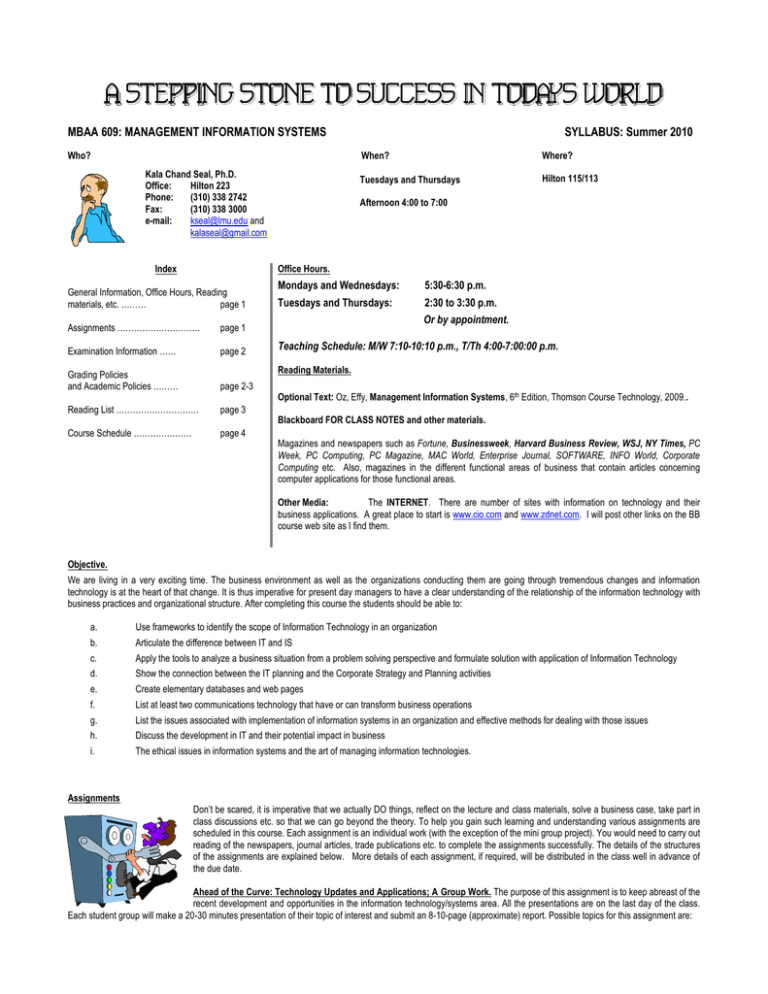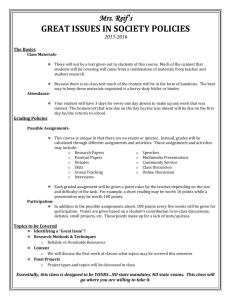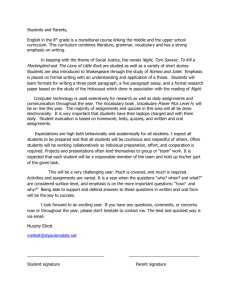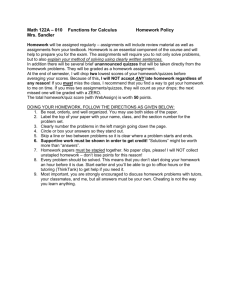
MBAA 609: MANAGEMENT INFORMATION SYSTEMS
Who?
Kala Chand Seal, Ph.D.
Office:
Hilton 223
Phone:
(310) 338 2742
Fax:
(310) 338 3000
e-mail:
kseal@lmu.edu and
kalaseal@gmail.com
Index
SYLLABUS: Summer 2010
When?
Where?
Tuesdays and Thursdays
Hilton 115/113
Afternoon 4:00 to 7:00
Office Hours.
General Information, Office Hours, Reading
materials, etc. ………
page 1
Assignments …………………………
page 1
Examination Information ……
page 2
Grading Policies
and Academic Policies ………
page 2-3
Reading List …………………………
page 3
Course Schedule …………………
page 4
Mondays and Wednesdays:
Tuesdays and Thursdays:
5:30-6:30 p.m.
2:30 to 3:30 p.m.
Or by appointment.
Teaching Schedule: M/W 7:10-10:10 p.m., T/Th 4:00-7:00:00 p.m.
Reading Materials.
Optional Text: Oz, Effy, Management Information Systems, 6th Edition, Thomson Course Technology, 2009..
Blackboard FOR CLASS NOTES and other materials.
Magazines and newspapers such as Fortune, Businessweek, Harvard Business Review, WSJ, NY Times, PC
Week, PC Computing, PC Magazine, MAC World, Enterprise Journal, SOFTWARE, INFO World, Corporate
Computing etc. Also, magazines in the different functional areas of business that contain articles concerning
computer applications for those functional areas.
Other Media:
The INTERNET. There are number of sites with information on technology and their
business applications. A great place to start is www.cio.com and www.zdnet.com. I will post other links on the BB
course web site as I find them.
Objective.
We are living in a very exciting time. The business environment as well as the organizations conducting them are going through tremendous changes and information
technology is at the heart of that change. It is thus imperative for present day managers to have a clear understanding of the relationship of the information technology with
business practices and organizational structure. After completing this course the students should be able to:
a.
Use frameworks to identify the scope of Information Technology in an organization
b.
Articulate the difference between IT and IS
c.
Apply the tools to analyze a business situation from a problem solving perspective and formulate solution with application of Information Technology
d.
Show the connection between the IT planning and the Corporate Strategy and Planning activities
e.
Create elementary databases and web pages
f.
List at least two communications technology that have or can transform business operations
g.
List the issues associated with implementation of information systems in an organization and effective methods for dealing with those issues
h.
Discuss the development in IT and their potential impact in business
i.
The ethical issues in information systems and the art of managing information technologies.
Assignments
Don’t be scared, it is imperative that we actually DO things, reflect on the lecture and class materials, solve a business case, take part in
class discussions etc. so that we can go beyond the theory. To help you gain such learning and understanding various assignments are
scheduled in this course. Each assignment is an individual work (with the exception of the mini group project). You would need to carry out
reading of the newspapers, journal articles, trade publications etc. to complete the assignments successfully. The details of the structures
of the assignments are explained below. More details of each assignment, if required, will be distributed in the class well in advance of
the due date.
Ahead of the Curve: Technology Updates and Applications; A Group Work. The purpose of this assignment is to keep abreast of the
recent development and opportunities in the information technology/systems area. All the presentations are on the last day of the class.
Each student group will make a 20-30 minutes presentation of their topic of interest and submit an 8-10-page (approximate) report. Possible topics for this assignment are:
MBAA 609: MANAGEMENT INFORMATION SYSTEMS
1.
2.
3.
4.
5.
6.
7.
8.
9.
10.
SYLLABUS: Summer 2010
Web 2.0
Cloud Computing: Definition, Opportunities and Challenges
CRM/Data Mining: Business Intelligence and Competitive Advantage
Opportunities in Mobile Space
Virtual World: Augmented Reality and Second Life
Knowledge Management: Technology, Applications and Challenges
Business Applications and Benefits of Social Networking Technology/User Generated Contents (Myspace, facebook, Youtube, LinkedIn, etc.).
Opportunities and Challenges of Outsourcing and Offshoring: A Long Term Problem for a Short Term Cure?
Going green with technology
Nanotechnology beyond the lab: Opportunities in Information Systems and issues
You can also select a topic of your own outside of the above list. However, you must let me know the topic by the beginning of the second week along with an outline of
what you plan to cover.
For each topic, the presentation as well as the report should include an explanation of the technology/concept involved, a business application example, the pros and cons,
and the issues facing businesses in using the technology. You can look at this assignment as a mini research project. In your report, you must include the relevant
references (with an upper limit of 10) and indicate the top two references that should be read by the readers to get more information about the topic. All students will be
responsible for reading at least the top references for each topic along with the reports created by the student groups.
Ethics and Youtube: This one is also an individual assignment and will entail creating a Youtube presentation of approximately 10 minutes on
ethical side of information systems and technology. The topic is for each of you to choose and can be on privacy, the environmental impact of information technology, the
social effect of information technology and the corresponding ethical dilemma, the issue of widening gap between haves and have-nots, the issue of multiprocessing and its
long term effect on learning, etc. Once you decide on the topic, pleas run it by me. The usual output is a PowerPoint presentation with voice narration that must be
converted to a movie and then upoloaded to Youtube. You need to send me only the link. There are tons of tutorials on Youtube to show how to make a movie out of
PowerPoint slides.
Quizzes. There are two quizzes scheduled to help you in studying and retaining the course materials. These are in-class and should take no more
than 15 minutes and each is worth 2% (total of 4%) of the course grade.
Case Study. Either two separate case studies or one case study with two parts will be assigned to each student. The student has to analyze the
information in the case, relate it to the concepts learnt in the class, supplement with outside readings, and produce databases, reports, etc. The actual cases and the detail
instructions for analysis will be distributed in the class. This is an individual assignment.
NONE OF THE ASSIGNMENT WILL BE ACCPETED LATE. THE ASSIGNMENTS ARE DUE DURING THE CLASS TIME ON THE DUE DATES INDICATED. IF IT IS
SUBMITTED AFTER THAT IT WILL BE CONSIDERED LATE AND WILL HAVE A LATE PENALTY OF 100%. ELCTRONIC SUBMISSION OF ASSIGNMENTS WI LL
BE ACCEPTED AND ARE ENCOURAGED.
Examinations and Quizzes.
To help you in keeping up with the readings, I will administer 2 quizzes as indicated in the course schedule and will consist of Multiple Choice, Fill in the Blanks, and
True/False types of questions and should not take more than 15-20 minutes to complete. Besides the quizzes, there will be a mid term and a
final examination. The final is somewhat non-cumulative, only the readings dealing with fundamental concepts will be included again.
All the examinations are of multiple choice and/or short answer type and may include a short case study. The exams will also include hands-on
components. You need to bring in a scan-tron (with answers to 50 questions on each side) for each of the examinations. The test will be from
materials covered in the class. Your class notes, therefore, are very important.
All the examinations must be taken to receive a passing grade and they must be taken as scheduled. A re-examination will be scheduled
only, AT THE DISCRETION OF THE INSTRUCTOR, for valid and documented medical reasons.
Distribution of Grades.
(%)
Points
Assignments (550)
Quizzes
Ahead of the Curve Group Project
Ethics and Youtube
Case Study (3 parts)
Class Participations:
2 x 3%
15 % (10+5)
10%
2 x 10%
04%
60
150
100
200
40
Examinations (450)
Mid term
Final
20%
25%
200
250
Grading Policy
Don't you want an "A" in this course? YOU CAN DO IT TOO!! Grades are exactly like the grades of a slope. If you want to go
higher, you have to put in a bit
more effort. In a car, you have
to have the speed (efficiency) as well as the torque (effectiveness) to cross that slope. Similarly in the course you not only have
to remember things but you
also must have the understanding. Otherwise you may stall in the middle (that is not too bad though, you get a partial view of
the
promised
land
beyond). BUT I AM SURE ALL OF YOU WILL TRY TO GET TO THE TOP and YOU SHOULD!! If you need an extra push from
me, just ask.
Your final grade is based on the total points earned in the course. A student will receive individual points score in each of his/her
work (for the group project grading, please refer to the project details). All of these scores will be combined at the very end of
the semester according to the different weights mentioned before and a combined point score will be determined. After
Dr. Kala Seal, H 223, (310) 338 2742.
kseal@lmu.edu
fax:(310) 338 3000
Page 2
MBAA 609: MANAGEMENT INFORMATION SYSTEMS
SYLLABUS: Summer 2010
obtaining such score for all the students, a distribution curve will be drawn and a student's grade will be determined according to his/her position on this curve.
Please note that only the final overall points will be curved, I will not curve the individual assignment or test.
However, to judge your performance in the assignments and in the exams use the following scale.
94-100% A
90-93%
A87-89%
B+
83-86%
B
80-82%
B-
77-79%
73-76%
70-72%
<= 69%
C+
C
CF
Academic Honesty.
In accordance with the University's academic honesty and integrity policy, no cheating of any kind will be tolerated with regards to any and
all work in the course. One instance of cheating will result in a failing grade in the course without the possibility of a withdrawal.
Others.
There are few more things that I want you to be aware of. First, it is a practice in our department for faculty members to visit class sessions taught by other faculty members.
We, therefore, may have visitors attending our class from time to time. Next, if you find after the first mid term, that your progress is not satisfactory then I suggest that you
see me immediately to decide your future strategy. Waiting till the end of the semester will not help and I may not be able to do anything for you as it will be too late then.
SPECIAL ACCOMMODATIONS: Students with special needs who need reasonable modifications, special assistance, or accommodations in this course should promptly
direct their request to the Disability Support Services Office. Any student who currently has a documented disability (physical, learning, or psychological) needing academic
accommodations should contact the Disability Services Office (Daum Hall # 224, x84535) as early in the semester as possible. All discussions will remain confidential.
Please visit www.lmu.edu/dss <http://www.lmu.edu/dss> for additional information.
***
All of the work in this course must be typewritten. No handwritten work will be accepted at any time of the course. If any of the assignments needs
graphs, charts or figures to be included, then I expect them to be of professional quality. Lack of quality in your work will cost you valuable points ********
Reading List.
1.
Ross, J. W., and Weill, P. (2002). “Six IT Decisions Your IT People Shouldn’t Make,” Harvard Business Review, November 2002, pp. 84-91.
2.
Afuah, A. and Tucci, C.L. (2002). Internet Business Models and Strategies, McGraw-Hill. Chapter 3, Competitive Landscape-Changing Properties of the Internet, pp.
32-48.
3.
Porter, M.E. (2001). “Strategy and the Internet,” Harvard Business Review, March 2001, pp. 63-78.
4.
Magretta, J. (2002). “Why Business Models Matter,” Harvard Business Review, May 2002, pp. 86-92.
5.
Tapscott, D, (2001) "Rethinking Strategy in a Networked World (or Why Michael Porter is Wrong about the Internet)," Strategy+Business, Third Quarter, Issue 24.
6.
Christensen, C. M., and Overdorf, M. “Meeting the Challenge of Disruptive Change”, Harvard Business Review, March-April, 2000. pp. 1-10
7.
Pink, D.H. (2005). “The Book Stops Here,” Wired, March 2005, Issue 13, No. 3
8.
Anderson, D. and Lee, H. “The Internet Enabled Supply Chain: From
http://www.manufacturing.net/scm/contents/pdf/anderson_lee_wp.pdf. Accessed on June 22, 2006.
9.
Laudon, K. C. and Traver C. G. (2004). E-Commerce: Business, Technology, Society, 2nd Ed., Addison Wesley., Chapter 3: The Internet and the World Wide Web: ECommerce Infrastructure.
10.
Brans, P. (2003), Mobilize Your Enterprise, Prentice Hall, Chapter 6, Wireless Network Technologies.
11.
Ratliff, John, “NTT DoCoMo and Its i-mode Success: Origins and Implications,” California Management Review, vol. 44, no.3 (spring 2002), p. 55-71
12.
Hoffer, J.A., Prescott, M.B., and McFadden, F. R. (2005). Modern Database Management, 7th Edition, Saddle River, NJ: Pearson Prentice Hall. Chapter 1, The
Database Environment, pp. 3-31.
13.
Rigby, D.K. and Ledingham, D. (2004). “CRM Done Right,” Harvard Business Review, November 2004, pp. 118-129.
the
“First
Click”
to
the
“Last
Mile”
Any reading that is not indicated as to be distributed in class is available from the LMU library through the journal collection.
Dr. Kala Seal, H 223, (310) 338 2742.
kseal@lmu.edu
fax:(310) 338 3000
Page 3
at
MBAA 609: MANAGEMENT INFORMATION SYSTEMS
SYLLABUS: Summer 2010
Course Schedule for Summer 2010*
Weeks
Dates
Class Activities
Explanation of the course and assignments. Introduction to Information Systems and its role
in Business Transformation.
1
29-Jun
Recommended
Readings
Class Notes, 1
Business Analysis of Organizational Problems: Systems Approach and Process Flow.
Group Formation
1-Jul
Business Analysis continued. From Process to Data Flow.
PFD and DFD continued with an in-class case study.
2
6-Jul
8-Jul
Introduction to World Wide Web: Web Page Creation and Publishing: Hands on Tutorials.
Case Study 1/Part 1 is Due
4
Class Notes, 2, 3, 4, 5,
and 13.
Information Systems as a Strategic Resource: Competitive Forces, Strategies, Internet, Value
Activities and Value Chains.
Case Study 1/Part 1 will be handed out
Quiz 1
3
Class Notes
Class Notes, 7, part of
9
Class Notes, 6, 7 and
8
13-Jul
Choice of Youtube topics is Due
15-Jul
E-business and applications.
Mid Term Examination (covered materials, may include hands on component on web
page creation)
Introduction to Database Management Systems: Use, Design and Issues.
Class Notes, 12
Data warehouse and business Intelligence
Introduction to digital signal and digitization concepts
Class Notes
Class Notes, 9
20-Jul
Networks and Telecommunications
22-Jul
Risks, Security and Disaster Recovery
Case Study 2/Part 2 will be handed out
Youtube assignment is Due (send me the link)
Quiz 2
Class Notes
5
27-Jul
Introduction to Various Levels of Information Systems.
IS Planning, Development and Implementation
Decision Support Systems, Artificial Intelligence and Knowledge Management
29-Jul
Class Notes
Technology Briefing Presentations: Group 1 and 2.
Case Study 2/Part 2 is Due (by midnight of Saturday, Aug 1)
Technology Briefings Presentations: Group 3, 4 and 5
6
3-Aug
5-Aug
All Tech Briefing Reports are due
Final Examination
* Above is a tentative outline and may be changed by the instructor during the semester based on the progress of the class.
Dr. Kala Seal, H 223, (310) 338 2742.
kseal@lmu.edu
fax:(310) 338 3000
Page 4






